 |
||
|
||
| ||
TABLE OF CONTENTSDo ATI and NVIDIA have different marketing strategies? Of course they do. Both companies have been trying to confuse potential customers. Let's take chip designations (and consequently video cards), for example. In case of the Canadian company, the XT suffix means the superlative degree, that is the top product in a series. To spite ATI, the Californian company decided to use the same suffix for the lowest products in a series. At one time users couldn't possibly understand what GeForce FX5600XT was and how it differed from the 5600. Moreover, the 5600XT 64-bit was slower than the 5200 128-bit... After that FX5700 cards appeared... What was faster: the 5700LE or the 5600Ultra? - You couldn't clear up the issue without tests. Each time a lot of clever words were said about the expediency of this or that new name... But both companies were little concerned about the confusion on the market, baffling users. Confusion with ATI products was still worse... We all remember the RADEON 9250, which was weaker than the 9200 (lower frequencies). Many smart words were said about pricing and this allegedly new product... OK, on we go... We all remember the R420 (it was later called the X800XT/PE/PRO) and its PCI-E counterpart - the R423. Six months after, the company launched THE SAME CHIP, but on the next revision (better as far as the yield of effective dies is concerned) under the name... R480. OK, forget about codenames... But why is it now called the X850XT? They toyed a little with frequencies for form's sake (±20 MHz) and here is it - an allegedly new product... And again marketing specialists blow their horns, parades, presentations, lots of nice words... What was the product? The same video card, as had been released six months ago... In 2002 the company launched the R300 - a new product, a new name - the RADEON 9700. Hurrah! The R350 is the overclocked R300 (improved process technology) - thus the new name RADEON 9800... The R360 is the old, but overclocked R300 - again a new name. But conscience prevented designers from calling it the 9900: too humble compared to the 9800 PRO... They called it the 9800XT. That is the chips are actually the same, only their revisions and names are different... I wonder what Pentium would have Intel launched now, if it had increased the version with each new stepping. It would have been Pentium45, not Pentium4. That's right, when nothing really new is added, all they can do is to goof us off with new names. In case of the X800-X850, they actually sell the same product FOR THE SECOND TIME. The question is... why NVIDIA dares applying the GeForce 6800 name to the NV40, cut down to 12 pipelines, to the NV41, which has had 12 pipelines from the very beginning, and even to the NV41, manufactured by the new process technology - NV42? These are all different revisions, but they are essentially the same, users will get the same effect no matter what card is installed - the NV40 with the reduced number of pipelines or the NV41/42. Things are somehow different in ATI (for example, RADEON 9500 128bit or RADEON 9600. - They are essentially the same, 4 pipelines. But in the first case it's the reduced number of R300 (RADEON 9700) pipelines, while in the second case the product initially had this number of pipelines). And now the renaming virus is caught by NVIDIA - GeForce 6600LE. But it's another story.
The photo below shows two dies (NV41 on the left and NV42 on the right). It's a perfect scale-down of the original dimensions.
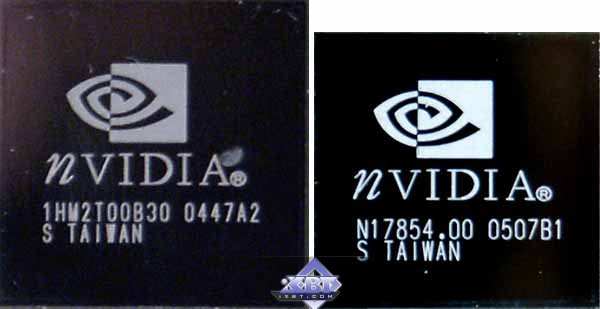 The insides of these two dies are essentially identical. Only process technologies are different (NV41 - 0.13 mkm, NV42 - 0.11 mkm), both dies are manufactured by TSMC. The new process technology gave ground to change the codename. But there is absolutely no reason to change the real name, as the chip operates in the same way. So they are all GeForce 6800. Here are the videos, which briefly illustrate the new product.
Up to now we have reviewed GeForce 6800 PCI-E - not just NV41-based, but also equipped with 256MB DDR SDRAM. Today we shall review a similar product, but with 128MB (and higher operating frequencies). This product is interesting in many aspects, so let's start the ball rolling.
Video card
The card is obviously based on the reference design. In fact, the only departure from the reference design is memory chips - less capacious than usual. We should also mention that the card is equipped with a couple of DVI connectors.
We have already seen relative dimensions of the GPU (NV42) at the beginning of this article. And this is how the graphics processor looks in full:
Let's compare it to the NV41 once again:
Besides the core dimensions, the chip carrier is also changed. GeForce 6800 (NV42) "lost" the protecting frame. Probably there are some design rules concerning die dimensions, which regulate the lack/presence of such a frame. We remember that both GeForce FX 5700 and RADEON X700, having smaller die dimensions than their senior brothers, don't have such a frame. Nevertheless, you should keep it in mind, if you are going to change your cooling system. You must be really careful, when you install it, not to damage the chip surface.
Potential buyers should take into account the large heatsink at the back of the PCB. Even though this heatsink is high above the motherboard surface, Albatron GeForce 6800 128MB PCI-E (PC6800) may still fail to fit into a number of motherboards, where the northbridge with a large heatsink is installed close to the PCI-E slot.
Bundle
Box.
Installation and DriversTestbed configurations:
VSync is disabled. Overclocking: we managed to overclock the core of this video card up to 440(!) MHz and still preserve operating stability. The memory limit is 810 MHz.  We monitored card's temperature during operation, there were expectedly no surges. The core stayed below 70°.
Test results: performance comparisonWe used the following test applications:
Game tests that heavily load pixel shaders 2.0.TR:AoD, Paris5_4 DEMO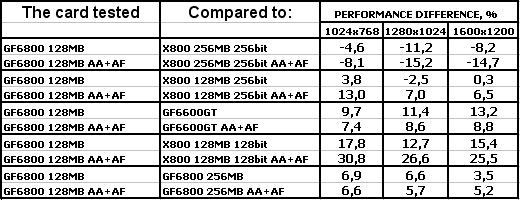 Even though this test is critical to shader performance, the memory bandwidth (i.e. memory operating frequencies of the GeForce 6800) also has a say: the higher memory operating frequency has an effect on the performance growth, even though the memory capacity of the model under review is smaller than in its 256-MB counterpart. In other respects it's approximately on a par with the ATI X800 128MB 256bit.
Game tests that heavily load vertex shaders, mixed pixel shaders 1.1 and 2.0, active multitexturing.FarCry, Research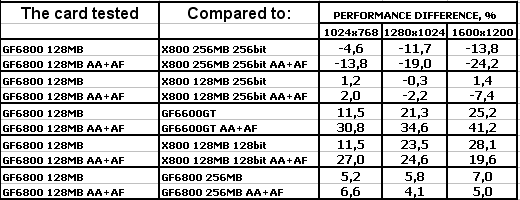 FarCry, Regulator
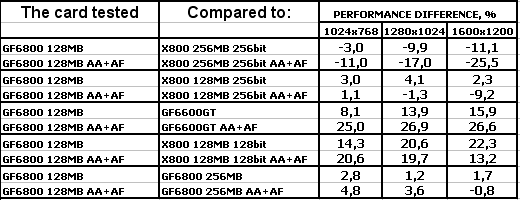 FarCry, Pier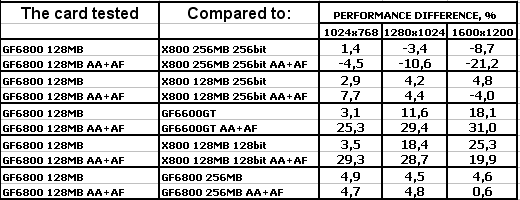 Here is the situation: the Albatron product fairs very well versus the X800 128MB 256bit; it's outperformed by the more expensive X800 256MB in heavy modes (mostly due to the increased memory bandwidth in the latter). It's quite OK on the whole. F.E.A.R. (MP beta)
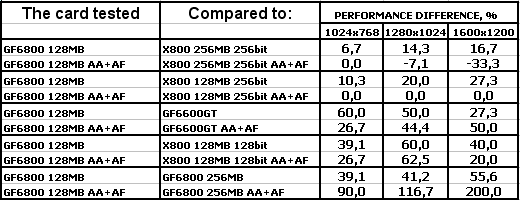 There is no reason to pay attention to heavy modes with AA+AF and highest quality in this game, because the gameplay gets below the tolerable level. The Albatron product demonstrated very good performance compared to its competitors. It fact it's a leader here. This is very indicative, because this test (this game) embodies a cohort of state-of-the-art and graphics-intensive games.
Game tests that heavily load both vertex shaders and pixel shaders 2.0Half-Life2: ixbt01 demo
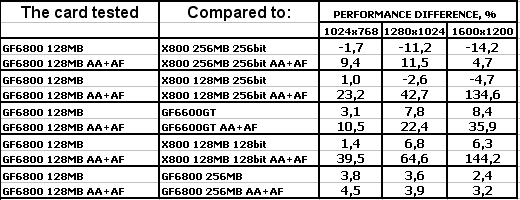 Half-Life2: ixbt02 demo
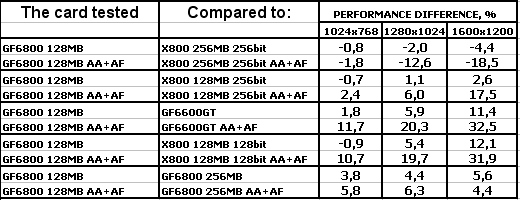 Half-Life2: ixbt03 demo
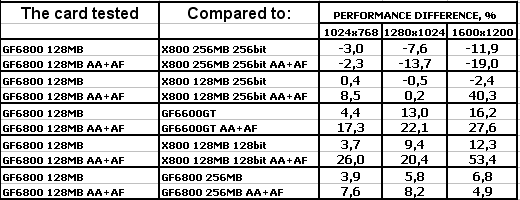 The situation is diverse. Victories, defeats, parities. Due to driver specifics, 128MB ATI cards drastically lose performance in heavy modes, as the resolution grows. The FPS level in this game allows even middle end accelerators to cope with high resolutions or AA+AF. That's why the GeForce 6800 fairs rather well.
Game tests that heavily load pixel pipelines with texturing, active operations of the stencil buffer and shader unitsDOOM III High mode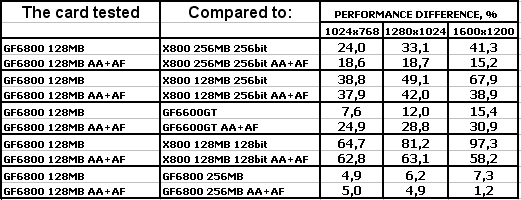 Chronicles of Riddick, demo 44
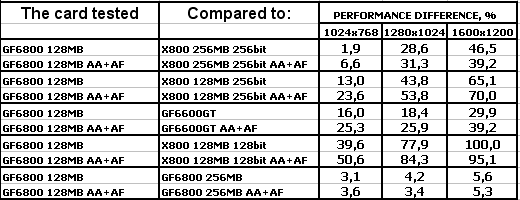 Chronicles of Riddick, demo ducche
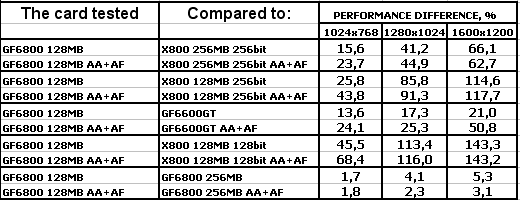 I guess there is no need to comment on the block of tests, where NVIDIA accelerators rule supreme due to a more flexible and longer render pipeline, streamlined and fast stencil-buffer operations, and the fine-tuned OpenGL driver.
Synthetic tests that heavily load shader units3DMark05: MARKS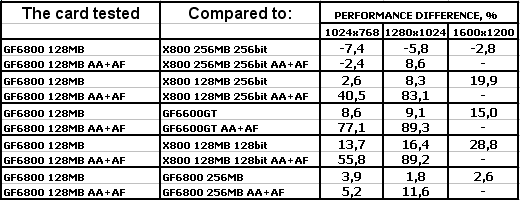 The results are similar to those in TR;AoD, where everything is up to the capacity of shader units.
ConclusionsAlbatron GeForce 6800 128MB PCI-E (PC6800) is an interesting product. Firstly, its performance level corresponds to a $210-$230 card. Secondly, it has a unique quiet cooling system, which will please many modders. Thirdly, it has good overclocking potential. But don't forget that GeForce 6800 PCI-E can be based on NV41 (with lesser overclocking potential) or on NV42. So we cannot guarantee that all these cards will be based on NV42, which is better at overclocking. And you shouldn't forget that the cooling system on the back of this card is bulky, so it may not fit into a number of motherboards. This video card is very stable, 2D quality in this sample is up to the mark: 1600x1200@100Hz - excellent sharpness.
You can find more detailed comparisons of various video cards in our 3Digest.
Albatron GeForce 6800 128MB PCI-E (PC6800) gets the Original Design award (August).

Theoretical materials and reviews of video cards, which concern functional properties of the GPU ATI RADEON X800 (R420)/X850 (R480)/X700 (RV410) and NVIDIA GeForce 6800 (NV40/45)/6600 (NV43)
Write a comment below. No registration needed!
|
Platform · Video · Multimedia · Mobile · Other || About us & Privacy policy · Twitter · Facebook Copyright © Byrds Research & Publishing, Ltd., 1997–2011. All rights reserved. | |||||||||||||||||||||||||||||||||||||||||||||||||||||||||